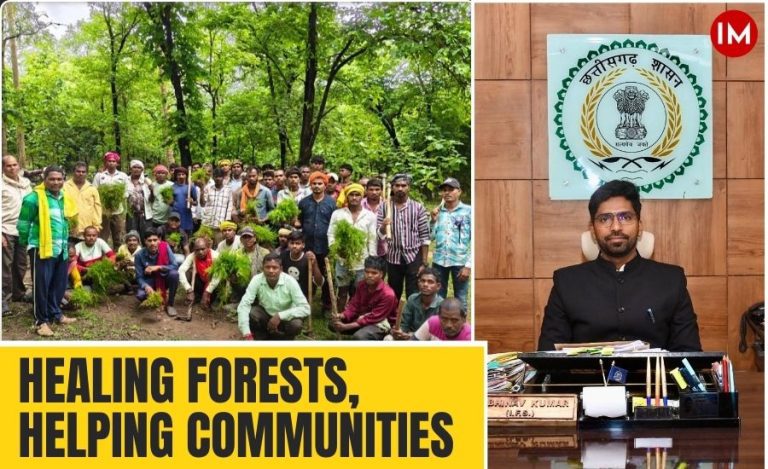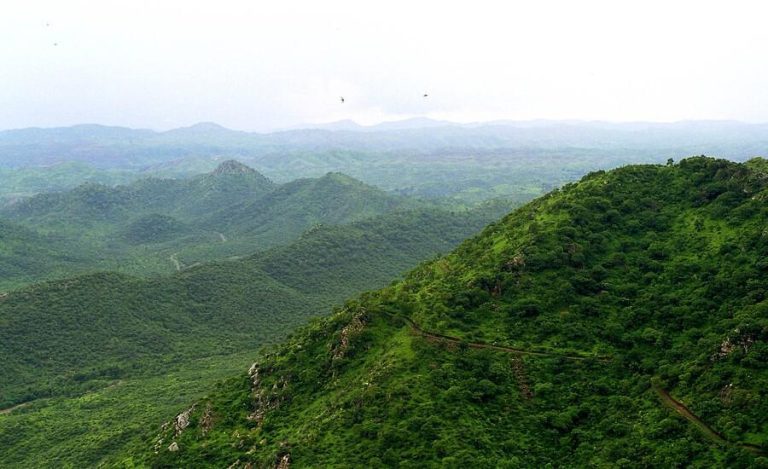Beautiful tulips bobbing their heads in the wind greet visitors to the hill township of Munsiyari, situated at a height of 9000 ft. Tourists flocking to this place in Pithoragarh district of Uttarakhand in the cold season are dazzled by the sight of the colourful tulips against the backdrop of white snow. A riot of colours against a white blanket of snow creates a beautiful contrast, reminding people of the brilliance of nature.
However, these beautiful flowers did not grow overnight. There’s a long story behind their emergence in the, hitherto, barren land. Indian Masterminds contacted the Divisional Forest Officer (DFO) of Pithoragarh, Dr Vinay Bhargav, to know how the garden of tulips sprang up in a previously barren land and what role the forest department played in it.

TULIPS AT 9000 FT
Tulips growing at 9000 ft in Munsiyari are the result of an initiative of the Uttarakhand Forest department involving the local communities. These days, the hill township and its adjoining villages are in the spotlight because of a tulip garden along the Thal-Munsiyari highway. The Forest Department developed the beautiful garden at the foothills of Panchachuli at an altitude of 9000 feet, with the help of local people. The development of a tulip garden at such a height is naturally arousing the curiosity of many and the forest department is being bombarded with questions from different quarters.
It was by no means an easy feat to develop a tulip garden at 9000 ft in 30 acres of land that had been barren for years and was used for burial of dead animals. The forest department and the local people toiled very hard to grow the tulips and develop the garden. And the results are there for all to see!

DFO Bhargav said, “We started this work in May 2019. The work of the Forest Department is to convert the barren land into forest land by restoring it through tree species. But, here, we focused on flowers instead of trees. We looked for species that can quickly cover the area to reduce the impact of degradation. Also, we had to correct the texture of the soil, which had completely deteriorated.”
He informed that the whole area had become a dumpyard for dead animals. Munsiyari being a tourist destination of Pithoragarh because of frequent snowfall, the challenge in front of the department was to create a model that would eliminate the problem of deforestation and attract tourists as well.

“That’s why we focused on flower species instead of tree species. We planted about 36 species, tulip being just one of them. Wild species like the Blue Iris, White Iris, Ranunculus, Fox glove, Burans, Dog tail, etc., were also planted.”
PROBLEMS FACED
Working on a garden at 9000 feet was not easy at all. On top of that, there is a lot of snow and the biting cold to deal with. “When we started this work, there was very heavy snowfall. There was about 12 to 15 feet snow all around. But one of the good things about tulip is, the more cold stress it gets, the better it flowers,” Dr. Bhargav said.
FIRST TIME IN THE WORLD


The officer also informed that they have achieved an off-season bloom. This has happened for the first time in the world. “We fed the tulips in the last week of May. It’s been a wonderful experiment. We can now extend the bloom season from 2 months to 5 or 6 months.”
EMPLOYMENT GENERATION
The tulip garden has generated employment in the area as well. As the local population was involved in the work, a community was formed for the unemployed youth. Its name is Munsiyari Eco-Development Committee (EDC).
“It was the real workforce behind this beautiful tulip garden. Its members were involved from inception to completion and now they take care of the maintenance. Local people are involved in the soil work, site preparation, planting and irrigation to the nurturing process, protection and monitoring of this garden.”

He also remarked that if not for the support from the local community, the tulip garden would not have come up so beautifully. He specially mentions EDC chairman Brijesh Dharmshaktu for his active support to this uphill task.
“Right now, about 12 to 15 farmers are directly connected with us. And, indirectly, hundreds of people are involved, as tourism is growing. However, our aim is to introduce more farmers to tulip growing. Tulip gardens boost sylviculture, horticulture and, also, the tourism sector. In this way, they provide additional opportunities for sustained rural self-employment,” he said.
FORMER CM RELEASES TULIP PICTURES
Former Uttarakhand CM Trivendram Singh Rawat released some pictures of the tulips and said, “I am happy to share the first pics of the successful pilot of my dream project – Munsiyari’s Tulip Garden. Set amidst the backdrop of Panchachuli ranges, this garden will be one of the biggest tulip gardens in the world and will transform tourism in the region.”

A WIN-WIN SITUATION
The actual story behind this initiative was “to check the erosive control of top soil caused due to past practices and also to negate the spread of the invasive weed Jangli palak (Rumex nepalensis) from these areas, due to huge grazing pressure,” Dr. Bhargav revealed.
Instead of routine planting of tree species and allied activities, which would have taken lots of years to stabilize; alternative innovative way of planting ornamental wild flower bulbs was chosen as an experiment on a small scale, which has paid off beautifully; with overall aesthetic improvement and a high visual impact.
Tulips are a clear winner with their high visual impact value. And the model site is already drawing tourist attention, which will help locals get economic benefits as well. Clearly, a win-win situation for all!
पिथौरागढ़ भ्रमण के दौरान मुझे डा० विनय भार्गव, IFS DFO पिथौरागढ़ और उनकी EDC टीम द्वारा मुन्स्यारी में 9000 फ़ीट की ऊंचाई पर स्थापित किए गए ट्यूलिप गार्डन के विषय मे जानने को मिला। उनकी टीम ने मौसम, ऊंचाई और अन्य पैमानों के अनुकूल कई प्रयोग किए जिससे उन्हें अपेक्षित सफलता मिली। pic.twitter.com/l3vSNZBsnD
— Tirath Singh Rawat (मोदी का परिवार) (@TIRATHSRAWAT) May 25, 2021


































